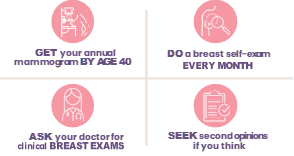The latest data from the American Cancer Society (ACS) shows women are being diagnosed with breast cancer more often at younger ages. The median age of breast cancer diagnosis in women is considered 62, but rising incidence rates in younger women are raising alarm. The 2025 Cancer Facts and Figures data by the ACS found women under 50 are now nearly twice as likely to be diagnosed with cancer as men the same age, largely attributed to a rise in breast cancer cases.

The 2025 Cancer Facts and Figures data by the ACS found women under 50 are now nearly twice as likely to be diagnosed with cancer as men the same age.
This concerning trend underscores the importance of understanding your personal risk factors and taking proactive steps toward early detection. While some risk factors are beyond your control, being informed and staying vigilant can make a significant difference in catching breast cancer early when it’s most treatable.
#1 RISK FACTOR: BEING A WOMAN
While other factors, such as family history and genetics, breast density, and atypical cells increase your risk for getting breast cancer, 75 percent of breast cancer diagnoses occur in women with no family history. So, if you are a woman with no other risk factors, you should:

FAMILY HISTORY
Family history is a risk factor for breast cancer. The first thing you should do is ask your relatives about their breast and ovarian cancer histories. If you have a history of breast or ovarian cancer among close relatives on either side of your family, you should:
- Be vigilant about your breast health
- Get your annual mammogram at least 10 years before the earliest breast cancer diagnosis in your family, or at age 40 – whichever is first
- Discuss genetic testing with your doctor. If you test negative for known breast cancer mutations, you are still at an increased risk for breast cancer
- Discuss other screening options with your doctor
Should I worry? No. Breast cancer is over 95 percent curable when it is detected early; this fact alone should motivate you to get screened and maximize your chances of finding any trace of early, curable cancer.

Use CheckMate, the Brem Foundation’s breast health quiz, to help you understand your personal risk factors for breast cancer and what steps you can take with your healthcare provider to protect your breast health.
Learn your personal risk factors for breast cancer. Get tools to take charge of your breast health.
DENSE BREAST TISSUE
In the United States, 65 percent of premenopausal women and 25 percent of postmenopausal women have dense breasts. Dense breasts have more connective tissue than fatty tissue.
You may wonder why this matters
This matters because women with dense breasts are 20 percent more likely to get breast cancer than women with fatty breasts. This increased risk is elevated because breast cancers in dense tissue are harder to find on mammograms than cancers in fatty tissue.
The only way to know whether you have dense tissue is through a mammogram. If you are unaware of your breast density and its implications for you, you should:
- Ask about breast density at your next mammogram
- If you have dense breasts, ask about further screening
- Discuss MRI, 3-D mammograms, and 3-D ultrasound with your doctor; you may have additional screening options
- Contact the Brem Foundation if you have trouble paying for additional screening
RISK MODELS
Gail, Claus, and Tyrer-Cuzik are the three primary risk models that are used to describe the relative impact of various breast cancer risk factors.
Each model takes a different approach to understanding how a woman’s unique combination of risk factors – including the risk factors listed above, as well as others – affects her overall chances of getting breast cancer.
Read about these risk models here.
WHAT NOW?
- Take the CheckMate breast health quiz to know your risk factors
- Get screened based on those risk factors
- Know and demand your rights
- Talk to your provider and schedule your mammogram today
*This blog was contributed by the Brem Foundation, whose mission is to maximize every woman’s chance of finding early, curable breast cancer through education, access, and advocacy.

